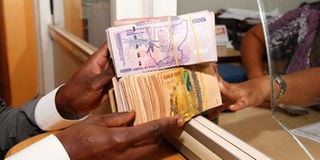Shilling is likely to remain stable in 2021 - Central Bank

Depreciation. Uganda shilling notes. On average, the shilling depreciated by 0.38 per cent in 2020. Photo | Rachel Mabala
What you need to know:
- Currency depreciation, for example, can be expected to affect the demand for money, aggregate demand, and the levels of prices and output, as well as to induce external and internal relative price shifts that alter the composition of the expenditure.
Despite economic challenges internally and globally, the Uganda shilling registered improved performance. Bank of Uganda says on average, the shilling depreciated by 0.38 per cent in 2020 compared to an appreciation of 0.6 per cent in 2019.
Exchange rate changes between currencies influence the behaviour of several macroeconomic variables over a varying time horizon.
Currency depreciation, for example, can be expected to affect the demand for money, aggregate demand, and the levels of prices and output, as well as to induce external and internal relative price shifts that alter the composition of the expenditure.
The executive director of research Bank of Uganda, Dr Adam Mugume told Daily Monitor on January 4 that the shilling has largely been stable in 2020 despite the Covid-19 pandemic that affected foreign exchange inflows, especially the tourism receipts.
“The relative stability is partly a reflection of subdued aggregate demand. The shilling depreciated by 3 per cent between February and May 2020 but appreciated by 3.3 per cent between May and December 2020,” he said.
“This reflects the effects of measures both domestic and global taken to mitigate the Covid-19 spread. On average, the shilling depreciated by 0.38 per cent in 2020 compared to an appreciation of 0.6 per cent in 2019,” Dr Mugume added.
In an era when countries are becoming increasingly linked to one another through trade and capital flows, the functioning of a country’s exchange rate regime is a critical factor in economic policymaking.
Currency policy in most African countries is characterised as being a flexible currency regime in nature without pegging the currency rate against the US dollars.
Explaining how currencies in the region performed, Dr Mugume said in 2020, the Kenya shilling depreciated by 9.4 per cent, Rwanda Franc by 5 per cent, South Africa Rand by 3.6 per cent, Tanzania shilling by 0.41 per cent.
“On a trade-weighted basis, (Nominal Effective Exchange Rate) appreciated by 0.5 per cent year-on-year,” he said.
Outlook
With gradual economic recovery gaining momentum in Uganda, there are hopes that the Uganda currency is likely to remain stable in 2021.
Giving insights on the future of the shilling in the first quarter of 2021, Dr Mugume said: “Going forward, the exchange rate is likely to remain stable on account of matched corporate activity; with a bias towards a mild depreciation due to Covid-19-related market uncertainty.”
“Dr Mugume added: “However, in 2021 and beyond, the shilling could benefit from a projected USD depreciation against other reserve currencies. Moreover, the outlook for a post-pandemic rebound in global growth and trade in 2021 and the reduced odds of unpredictable trade wars should lead to a reduction in exchange rate volatility.”
The general election in Uganda is happening mid this month with presidential and parliamentary election scheduled for January 14.
Asked whether the forthcoming general election will affect the shilling, Dr Mugume said the uncertainty impact on the exchange rate induced by elections should have had an impact by now.
“We are continuing to see exchange rate appreciation and offshore investors have increased their investments by about $140 million in two months to December 2020,” he said.




